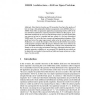Free Online Productivity Tools
i2Speak
i2Symbol
i2OCR
iTex2Img
iWeb2Print
iWeb2Shot
i2Type
iPdf2Split
iPdf2Merge
i2Bopomofo
i2Arabic
i2Style
i2Image
i2PDF
iLatex2Rtf
Sci2ools
BTW
2005
Springer
2005
Springer
DBMS Architecture - Still an Open Problem
More than two decades ago, DB researchers faced up to the question of how to design a data-independent database management system (DBMS), that is, a DBMS which offers an appropriate application programming interface (API) to the user and whose architecture is open for permanent evolution. For this purpose, an arral model based on successive data abstraction steps of record-oriented data was proposed as kind of a standard and later refined to a five-layer hierarchical DBMS model. We review the basic concepts and implementation techniques of this model and survey the major improvements achieved in the system layers to date. Furthermore, we consider the interplay of the layered model with the transactional ACID properties and again outline the progress obtained. In the course of the last 20 years, this DBMS architecture was challenged by a variety of new requirements and changes as far as processing environments, data types, functional extensions, heterogeneity, autonomy, scalability, etc...
| Added | 26 Jun 2010 |
| Updated | 26 Jun 2010 |
| Type | Conference |
| Year | 2005 |
| Where | BTW |
| Authors | Theo Härder |
Comments (0)

